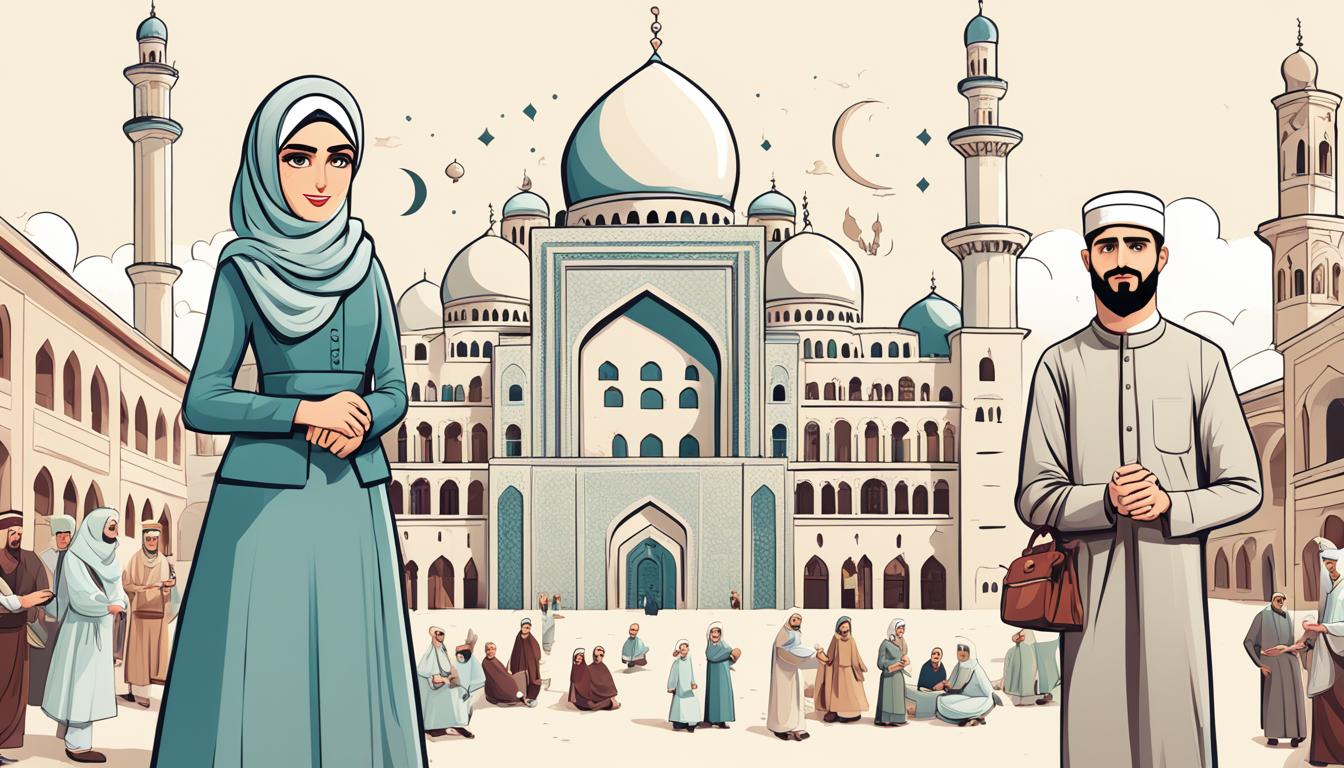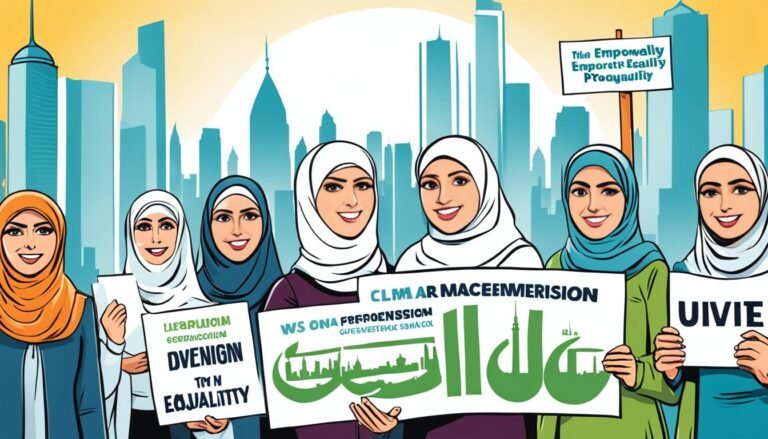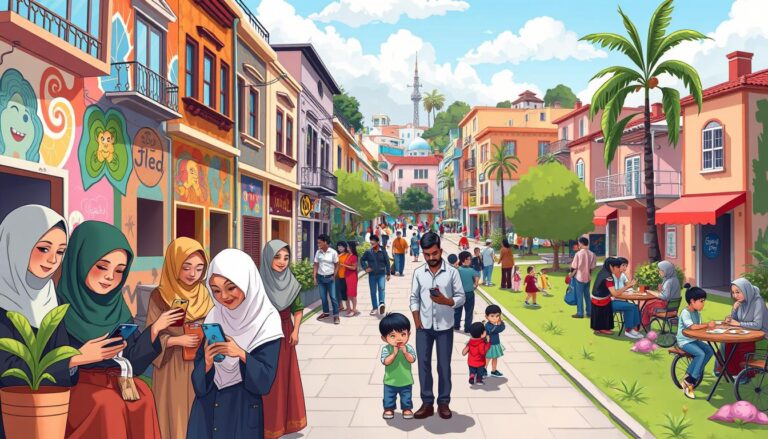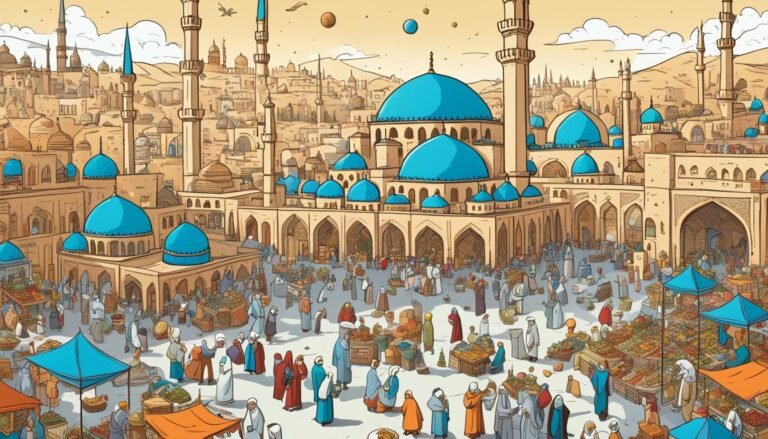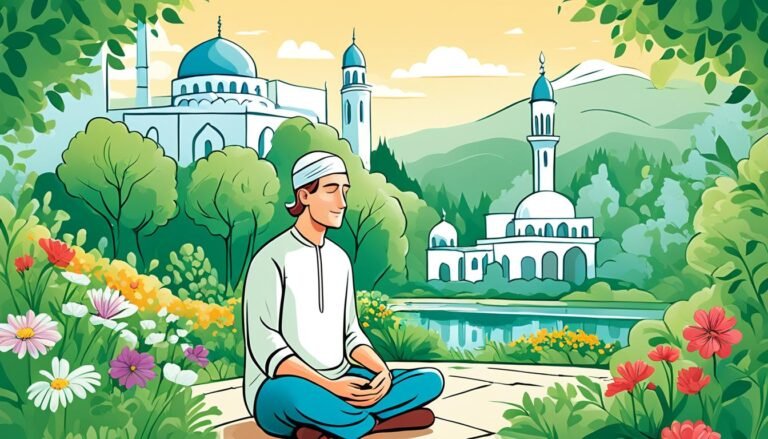Islamic Modernism: Navigating Tradition and Change
Imagine if Islamic teachings could grow to include modern values while keeping faith at its core. This idea is key to Islamic Modernism, a movement that started in the mid-19th century. It faced the challenges of Western colonialism. This movement blends Islamic beliefs with democratic values, civil rights, and logical thinking. It tries to mix deep traditions with today’s society needs.
Islamic Modernism is more than just a pushback; it’s a deep change in Islamic thought. Figures like Sir Sayyid Ahmed Khan and Muhammad Abduh wanted to rethink the Quran and Sunnah. They pushed for a flexible view of Islamic law to fit today’s world. This shows the movement’s drive to bring Islamic values into public life, setting it apart from secularism and Salafism.
Looking into this journey of balancing old and new, we see how Islamic Modernism shapes our views on faith, ethics, and society. It’s a story of how faith can evolve with the times.
Key Takeaways
- Islamic Modernism started in the 19th century as a response to Western colonialism.
- Key figures include Sir Sayyid Ahmed Khan and Muhammad Abduh.
- The movement tries to blend Islamic faith with modern values like democracy and civil rights.
- It supports rethinking core Islamic texts for today’s world.
- Islamic Modernism stresses the importance of religious faith in public life.
The Essence of Islamic Modernism
Islamic Modernism is a key movement in Islamic thought. It aims to update Islamic teachings for today’s society. To grasp its essence, we must look at its historical context of Islamic thought. This includes the 19th century, when Muslims debated how to keep their faith relevant in a changing world.
Definition and Historical Context
Scholars started Islamic Modernism to blend the Qur’an and Sunnah with modern ideas. Muhammad Abduh and Sir Sayyid Ahmad Khan led the reform efforts. They sparked debates on keeping Islamic identity while accepting global influences.
Evolution of Modern Islamic Thought
The evolution of Islamic thought shows a constant dialogue between old and new. This has led to different views on issues like gender equality and personal freedom. Islamic Modernism sees faith as a guide for ethics and reason. Scholars like Jamal ad-Din al-Afghani pushed for adding modern sciences to Islamic studies while keeping Islamic law’s core.
Today, Islam’s views are shaped by these debates. Muslims face challenges with modern values and technology. They need to make thoughtful choices about these issues.
Islamic Modernism: Navigating Tradition and Change
The journey of balancing faith and progress in Islamic modernism shows the challenges and chances we face in a fast-changing world. Scholars and thinkers bring different views, aiming to connect with today’s ideas while keeping Islamic values. This mix helps us see that old beliefs and new ideas can live together, making faith and society richer.
Balancing Faith and Progress
Islamic modernists like Muhammad Iqbal, Sir Syed Ahmed Khan, and Fazlur Rehman wanted to blend tradition with modern life. They believe in a version of Islam that accepts modernity and its values. They say justice, kindness, and being morally upright are key parts of faith.
Mufti Taqi Usmani shows that Islam has always been open to change, giving examples of its flexibility. Islamic modernism’s slow and careful approach, as Fazlur Rehman explains, helps defend faith against Western criticism. This leads to a useful talk on how Islamic values can help today’s life.
Shireen P. Hunter talks about three key ideas of modernity that help it connect with religion: using reason, focusing on today’s society, and seeing people as the source of political power. These ideas help us find a balanced way to deal with modern issues while valuing traditional wisdom.
Sir Syed Ahmed Khan’s way of thinking marked a big change in Islamic thought, pushing for ijtihad, or independent thinking. His ideas moved away from just following old interpretations, encouraging Muslims to think more deeply about their faith. This search for balance in faith and progress tells a story of dialogue, understanding, and growth in the Islamic world.
Reform Movements within Islam
The world of Islamic reform shows a long history of change and growth. These movements aim to blend old beliefs with new realities. They have brought forward many important leaders and efforts to update the faith. These changes show the wide range of views and adaptations in today’s Muslim world.
Key Figures in Islamic Modernism
Many leaders have become key in Islamic Modernism. They’ve worked to improve education, use reason, and rethink old texts. Names like Sir Sayyid Ahmed Khan, Muhammad Abduh, and Jamal ad-Din al-Afghani stand out. They’ve helped push for progress in Muslim communities by updating Islamic teachings for today’s world.
Historical Reform Efforts
Reform efforts over time show how Islam has changed to meet new challenges. For example, Al-Azhar’s updates show how education and laws in Islam have changed. These changes call for a closer look at old laws, making them fit today’s society better.
Women have played a big part in these changes. They’ve shaped education, culture, and community life. Seeing knowledge as a key duty shows Islam’s push for intellectual growth and progress.
| Key Figures | Main Contributions | Impact on Reform Movements |
|---|---|---|
| Sir Sayyid Ahmed Khan | Established educational institutions | Promoted rationality and modern science |
| Muhammad Abduh | Advocated for reinterpretation of texts | Influenced modernist thought across regions |
| Jamal ad-Din al-Afghani | Encouraged political activism | Fostered unity among Muslims for reform |
The mix of historical efforts and key figures shows the complex nature of Islamic reform over time. It highlights the faith’s diverse and lively character.
Cultural Renaissance in Contemporary Islam
The cultural renaissance in contemporary Islam is a vibrant revival. It blends traditional values with modern expressions. Artists and writers take inspiration from their Islamic heritage and global trends. This creates a unique identity that connects with people worldwide.
Influence on Literature and Arts
Islamic stories and beauty have deeply influenced literature and the arts. Sufi poetry, full of spiritual and emotional depth, inspires today’s writers. Art forms like painting and calligraphy show the link between faith and creativity in contemporary Islamic culture.
This renaissance has led to new art movements. They honor Islamic heritage and welcome new ideas.
Integration of Modern Values
Modern values are now part of Islamic thought. Discussions focus on equality, social justice, and freedom of speech. This change encourages looking at cultural practices anew.
It promotes inclusivity and diverse expressions of identity among Muslims. This dialogue is progressive and stays true to Islamic principles.
Theological Adaptation and Religious Reinterpretation
The talk about changing Islam shows a big move towards mixing reason and ethics in faith. This change is not just about keeping old ways but also about fitting into today’s world. It leads to a wider, kinder view of faith that matches today’s moral standards.
Embracing Rationality and Ethics
Adding ethics and reason is key to this change. Muslim scholars and thinkers push for a way that mixes religious teachings with today’s needs. They say no to strict readings of holy texts, choosing ones that support being open, fair, and caring for others. They also encourage people to use their own thoughts and direct feelings of the divine to connect deeply with their faith.
Updates to Islamic Jurisprudence
Changes in Islamic law are also important for making it fit today’s world. This new view highlights the need for thinking on one’s own, or ijtihad, to tackle today’s complex issues while staying true to the Qur’an and Sunnah. Scholars believe updating legal views for today helps Muslims deal with new problems. These changes make Islamic law more relevant and help start important talks worldwide.
Modernity and Faith: Challenges Encountered
In today’s world, many people have wrong ideas about Islam and Muslims face big challenges. To overcome these, we need to focus on education and talking across cultures. It’s crucial to understand each other and clear up wrong images that lead to bias. We must work together to respect and value our differences in the Muslim community.
Addressing Misconceptions and Stereotypes
Wrong ideas about Islam spread when there’s no true representation. Education is key to fighting these wrong beliefs. By talking openly about what Islam teaches and how it’s lived, we can close cultural divides. Showing the variety within the Muslim world helps fight harmful stereotypes. Together, we can change how the world sees Islam.
Technological Advancements and Their Relevance
Technology is also changing how Muslims interact with the world. It’s used for learning, staying in touch, and building communities. Technology does more than just make life easier; it connects people and offers new ways to solve problems that respect Islamic values. This balance of old and new helps keep faith and modern life together.
Progressive Islam: A New Wave of Thought
New voices in Islam mark a key shift in thought. Young scholars and activists push for a more inclusive view of Islam. They focus on social justice, human rights, and accepting different beliefs. This movement helps connect faith with modern life.
New Voices in the Muslim Community
Intellectuals are leading this change. They talk about how Islam fits with democracy, religious freedom, and accepting different beliefs. Their ideas bring people together, making a space where everyone’s views are heard.
Women’s Rights and Empowerment Movements
Women’s rights are a big part of this new thinking. Groups are fighting against old beliefs that don’t treat women fairly. They want to show that women can be leaders and get an education. This is important for a fair and respectful society.
| Key Topics | Description |
|---|---|
| New Voices in Islam | Emerging scholars and activists advocating for progressive interpretations of Islam. |
| Progressive Muslim Thought | A focus on social justice, human rights, and the integration of modern values. |
| Women’s Rights in Islam | Addressing gender equality through reinterpretation of Islamic teachings. |
| Empowerment Movements | Encouraging women’s leadership and education as keys to societal progress. |
Societal Transformation through Modern Islamic Practices
Today, Islamic practices are changing a lot. They’re blending old values with new knowledge. This change is big for education in Islam. It’s pushing Muslim communities towards new ways of learning. These new ways help people think deeply and understand their faith better.
Impact on Education and Scholarship
In Muslim communities now, education is changing. It’s becoming more innovative. Students learn both Islamic teachings and modern subjects. This mix helps them grow spiritually and intellectually.
- Enhanced curriculum focusing on critical thinking
- Collaboration with global academic institutions
- Encouragement of interdisciplinary studies
Combining Islamic teachings with modern education is key. It helps create a generation that’s deeply rooted in faith. And they’re also ready to face today’s complex world.
Islam’s Role in Global Discussions
Muslims are playing a bigger part in global talks. They’re making their voices heard on big issues. These include human rights, taking care of the environment, and improving lives.
| Global Discussion Topic | Muslim Community Initiatives | Impact on World Affairs |
|---|---|---|
| Human Rights | Advocacy and legal reforms | Strengthening global human rights frameworks |
| Environmental Issues | Development of sustainable practices | Influencing international environmental policies |
| Socio-Economic Development | Investment in education and healthcare | Contributing to equitable global development |
Muslim communities are playing a big role in world affairs. They’re working together to make the world fairer and more welcoming for everyone.
Conclusion
The conclusion on Islamic Modernism shows a lively mix of old and new. It’s a blend where modern life meets Islamic traditions, seen in fashion and art. This mix helps create a unique identity while tackling big issues like sustainability and human rights. It’s all based on fairness and kindness, as taught in Islam.
Even with progress, Islamic reform still has hurdles. Communities are trying to keep up with changing times and new tech while holding onto their beliefs. There’s still a lot of wrong ideas and biases about Islam. That’s why talking across cultures is key to understanding and respect.
The strength of Islam is clear in its focus on learning and new ideas. A saying from a respected source tells us getting knowledge is a key duty for all Muslims. This shows the faith’s ability to adapt and grow.
Looking ahead, Islamic modernism offers hope for the future. It’s a path that keeps faith and progress in balance. By talking openly and blending new values, Islamic traditions can thrive. This leads to a future full of chances for change and cultural growth.
Source Links
- Islamic modernism
- Islam and Modernity: Key Issues and Debates
- What is “modernism”? What serious issues does it raise among Muslims.
- Modernism and the Art of Muslim South Asia | Iftikhar Dadi | University of North Carolina Press
- Is it Possible to Reconcile Islam and Modernity?
- No title found
- Islamic Modernism and the Re-Enchantment of the Sacred 9781474478731 – DOKUMEN.PUB
- Islam, Revival, and Reform – Syracuse University Press
- Islam and Modern Trends | Religious Studies Center
- Modern Islamic Thinking and Activism
- Exploring Islamic Culture: Its Roots and Global Influence
- Muslim Modernism, Islamic Law, and the Universality of Human Rights
- Towards An Islamic Theory of Culture Part II: On Islamicates and Third Ways
- The Reconstruction Of Religious Thought In Islam Summary PDF | Muhammad Iqbal
- The Weight of the Predecessors: Adaptation, Critique and Transformation
- Challenges of Islamic Modernism in the Indo-Pakistan Subcontinent
- Islamism, Islamic Modernism and the Search for Modern Authenticity in an Imaginary Past
- Reformist Muslims in Contemporary America
- Religions
- Continuity and Change of Traditional Islamic Law in Modern Times: tarjīḥ as a Method of Adaptation and Development of Legal Doctrines
- Islam and Modernity: Navigating Challenges and Embracing Opportunities
- Introduction: Historicism, Modernity and Religion

